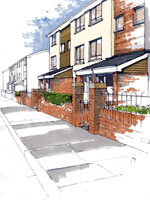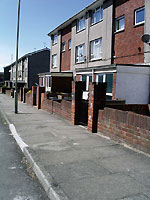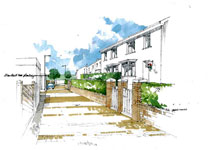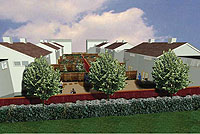The holistic approach to estate improvement initiated by Valleys to Coast (V2C) is about to increase in momentum. Action plans have now been completed that will see a range of innovative improvements being piloted in partnership with local tenants and residents. In this article, Nigel Draper, explains the approach taken in Bridgend.
Background
 \’We always understood that improving run-down council estates required more than simply attempting to achieve the Welsh Housing Quality Standard. We knew that listening to the needs of local people and then taking a joined-up approach would lead to more sustainable outcomes.\’
\’We always understood that improving run-down council estates required more than simply attempting to achieve the Welsh Housing Quality Standard. We knew that listening to the needs of local people and then taking a joined-up approach would lead to more sustainable outcomes.\’
The V2C Estate Improvement Programme (EIP) started in August 2005 with the appointment of a multi-disciplinary team of consultants led by Powell Dobson Urbanists (PDU), supported by Ashton Associates Wales, Barbara Castle Ltd, John Campion Associates and Anthony Jellard Associates.
\’V2C were very pleased that a local consortium won the UK wide tender. We were very impressed by their track record and the depth of experience and expertise that the PDU team offered. Our decision to appoint them has been vindicated by the high quality of their work and by the innovative, but very practical solutions that they have proposed.\’
 The programme was designed to identify and address key improvement issues on four V2C estates (Marlas, Wildmill, Caerau Park and Tudor). Each estate presented a different set of physical challenges arising from street layout, house design and topography, as well as a complex array of social issues. V2C adopted a methodology that would enable lessons to be learnt from these areas that could be applied across other parts of V2C\’s housing stock.
The programme was designed to identify and address key improvement issues on four V2C estates (Marlas, Wildmill, Caerau Park and Tudor). Each estate presented a different set of physical challenges arising from street layout, house design and topography, as well as a complex array of social issues. V2C adopted a methodology that would enable lessons to be learnt from these areas that could be applied across other parts of V2C\’s housing stock.
The EIP comprised a number of phases where regular tenant and resident consultation was used to:
- help identify local important issues
- provide a regular reality check, and
- engender a genuine sense of ownership and engagement on each estate
The phases are summarised in the table below.
| Phase | Timetable |
| Audit and identification of issues and problems | September/December 2005 |
| Community consultation no. 1 | December 2005 |
| Analysis and prioritisation of key issues | Spring 2006 |
| Proposals to resolve/address key issues | Summer 2006 |
| Community consultation no. 2 | July 2006 |
| Development of pilot projects to test/explore opportunities for estate improvement | Autumn 2006 |
| Budgeting and action planning | December 2006/January 2007 |
| Community consultation no. 3 | March 2007 |
| Implementing pilots and roll out | 2007-2010 |
Key issues
The audit phase examined and explored a range of factors including:
- physical location and context
- layout and the built environment
- landscape and public, private & anonymous space
- environmental quality
- movement and linkages
- housing supply and demand
- household make-up and demographic profile
- community services and community development issues
As well as responding to questions relating to the above, tenants and residents were also invited to describe key problems and issues facing people living on the estates. A range of consultation approaches were adopted including one to one meetings, estate walkabouts with local people, councillors and other stakeholders and consultation meetings.
Among the concerns that arose during the audit and community consultations were:
- problems associated with parking, traffic and road/street safety
- inappropriate use/nuisance behaviours in communal/public areas
- lack of private, defensible space around homes
- problems linked to antisocial activity on large areas of \’anonymous\’ open green space
- building design and street layouts that are no longer appropriate or fit for purpose
- lack of play, recreation and leisure facilities across age groups
- lack of community facilities
Although V2C staff were well aware of the generality of problems on these estates, the work by PDU and the feedback from tenants and residents has proved invaluable in helping V2C to develop a coherent response.
Masterplanning and local pilot projects
During the summer of 2006, a masterplan for each estate was prepared which established a robust context and foundation for the comprehensive and holistic improvement of each estate. A number of strategic recommendations relating to neighbourhood management and the development of community service hubs were also presented by PDU. These recommendations are broadly in-line with V2C\’s own strategy and are currently being considered by the V2C Management Team.
On a more detailed basis, a series of proposals that addressed key issues arising at particular locations were designed by the multi-disciplinary consultant team. These proposals were tested through further estate based consultations and stakeholder workshops before being developed into discrete and concrete pilot projects during the latter part of 2006.
V2C response
V2C have accepted the proposed pilots and with the support of PDU and cost surveyors Davis Langdon, have recently completed a series of budgeting and planning workshops. This process has enabled V2C to prioritise proposed interventions and to move towards the implementation of the first series of pilot projects in 2007/08.
The range of pilot projects that will address the key challenges of meeting the WHQS and fundamentally improve the external environment on each estate, include the following.
Marlas Estate
- Creating enclosed gardens and providing car spaces
- Connecting streets
- Improving public space
- Creating Home Zones
- Community allotments and communal gardens
Wildmill Estate
- Improving flats and enclosing boundaries
- Creating enclosed gardens (rear)
- Improving front gardens
- Enhancing streetscape
 Caerau Park Estate
Caerau Park Estate
- Landscaping and improving communal space
- Providing off street parking
- Street planting/lighting
- Footpaths
- Buffer planting
Tudor Estate
- Improving the entrance road and layout
- Secure binstore/recycling point
- Buffer planting
- Creating overlooked car-parking
- Improving footpath to community park
Creation of private gardens and improved defensible space
 The first series of pilots for 2007/08 will seek to resolve problems linked to large areas of \’anonymous\’ open space and the lack of private, defensible space around homes.
The first series of pilots for 2007/08 will seek to resolve problems linked to large areas of \’anonymous\’ open space and the lack of private, defensible space around homes.
A variety of challenges arise from the design and layout of a number of V2C estates. The \’radburn type\’ layout adopted by many council architects and planners when the estates were built is no longer fit for purpose and requires a radical redesign to enable these areas to become sustainable. \’I recall John Rouse from the Housing Corporation in England saying that there is no alternative to radical and aggressive surgery to make \’radburn\’ sustainable and from our experience to date, I\’m sure he is right,\’ Nigel commented.
Community consultation on all four estates identified community safety as an important priority. On Marlas, Wildmill and Tudor estates in particular, the consultations revealed high levels of demand for the conversion of anonymous green space and the creation of more secure and defensible forms of private and communal space.
V2C intends to employ a highly inclusive, realistic and practical planning process with local tenants and residents to design the layout and boundaries of the new gardens and communal areas. It is anticipated that the main areas of work required will be relatively simple and will include:
- demolition/removal of existing boundaries/walls
- creation of new boundaries between individual gardens
- creation of new boundaries adjacent to public/communal space
In order to properly address community safety, security and privacy issues, as well as bringing sustainable improvements to the estate environment in general, it is clear that all properties in any particular street must be included in the project. If V2C are not able to include all properties, the organisation would fail to address the security needs of local people.
Affordability constraints
All V2C estates display a mix of tenure in various proportions. The principal forms of tenure are:
- V2C tenants
- V2C leaseholders
- private owner occupiers
- private tenants
Research carried out as part of the EIP indicates that many tenants from the EIP estates are benefit dependant. In addition, many owner occupiers are asset rich/income poor and may also be benefit dependant. This clearly raises affordability issues which may constrain V2C\’s ability to make the necessary changes.
For V2C tenants, the organisation is able to carry out the required changes and works simply by obtaining their consent and co-operation. In order to include all properties in a street, V2C is proposing that key two principles be established for private owners. The first principle is that the enclosed garden land is gifted – transferred free of charge to owner occupiers. It is also envisaged that owners will be asked to make a contribution based upon the average cost of works per household.
Many owner occupiers will be able to increase existing mortgage borrowings or obtain other funds secured on the increased value of their property. However, where affordability remains an issue, V2C is working with Bridgend Lifesavers Credit Union to secure a further/alternative option. If, during the pilot projects, owner occupier households are encountered where affordability is a critical issue, these will be addressed on a case by case basis.
These principles will be tested and evaluated through consultation and negotiation during the pilot period and if appropriate, further refinement of the process may then be proposed.
Technical constraints
The pilot projects may be constrained by a number of more technical issues including:
- location of utilities
- established rights of way
- adopted footpaths and highways
- group transfer of title/conveyancing
- Welsh Assembly Government endorsement
The pilot process will provide the opportunity to explore these issues and establish processes to address these constraints. Initial contact with Bridgend County Borough Council Highways and Planning Departments to facilitate the pilot projects has been positive and constructive.
Promoting healthy lifestyles
Alongside the physical improvements and creation of private gardens, the V2C\’s People and Places Team is investigating sources of grant and project funding to support the development of gardening skills on estates and to promote gardening as an element of healthy lifestyles. V2C have deliberately attempted to combine community development approaches to build capacity in parallel with the physical transformation of estate environments.
Looking ahead
\’We are excited by the opportunity to begin to transform these estates, but we are aware that the next phase of our work will be complex and challenging,\’ said Nigel. \’However, we are convinced that the pilot approach and methodology, combined with our commitment to working with local people every step of the way, will give us the best chance of success,\’ he concluded.
Nigel Draper is Community Regeneration Manager with V2C, Nigel.Draper@v2c.org.uk.